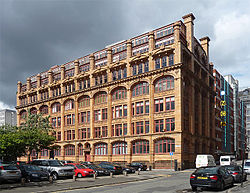
Wilmslow Road is a major road in Manchester, England, running from Parrs Wood northwards to Rusholme where it becomes the Oxford Road. The name of the road changes again to Oxford Street when it crosses the River Medlock before reaching Manchester city centre.
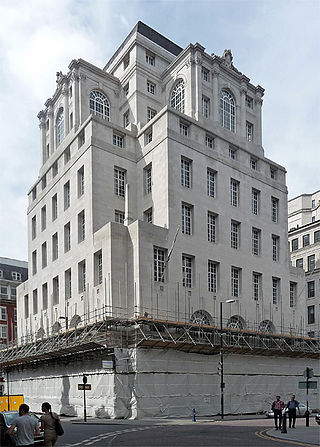
100 King Street, formerly the Midland Bank, is a former bank premises on King Street in Manchester, England. It was designed by Sir Edwin Lutyens in 1928 and constructed in 1933–35. It is Lutyens' major work in Manchester and was designated a Grade II* listed building in 1974.

Sunlight House is a Grade II listed building in the art deco style on Quay Street in Manchester, England. Completed in 1932 for Joseph Sunlight, at 14 storeys it was the tallest building in Manchester, and the top floors of turrets and multiple dormer windows and mansard roofs create a distinctive skyline.

Piccadilly Gardens is a green space in Manchester city centre, England, on the edge of the Northern Quarter.

Edgar Wood was a British architect, artist and draftsman who practised from Manchester at the turn of the 20th century and gained a considerable reputation in the United Kingdom. He was regarded as a proponent of the Arts and Crafts movement which was prevalent between 1860 and 1910.

The architecture of Manchester demonstrates a rich variety of architectural styles. The city is a product of the Industrial Revolution and is known as the first modern, industrial city. Manchester is noted for its warehouses, railway viaducts, cotton mills and canals – remnants of its past when the city produced and traded goods. Manchester has minimal Georgian or medieval architecture to speak of and consequently has a vast array of 19th and early 20th-century architecture styles; examples include Palazzo, Neo-Gothic, Venetian Gothic, Edwardian baroque, Art Nouveau, Art Deco and the Neo-Classical.

Kendals is the previous name of a department store in Manchester, England. Since 2005, the store now operates as House of Fraser. The store had previously been known during its operation as Kendal Milne, Kendal, Milne & Co, Kendal, Milne & Faulkner, Harrods or Watts.

Bridgewater House is a packing and shipping warehouse at 58–60 Whitworth Street, Manchester, England. It is recorded in the National Heritage List for England as a designated Grade II listed building.

Edward Walters was an English architect.

Princess Street is one of the main streets in the city centre of Manchester, England. It begins at Cross Street and runs approximately eastwards across Mosley Street, Portland Street and Whitworth Street until the point where it continues as Brook Street and eventually joins the A34.
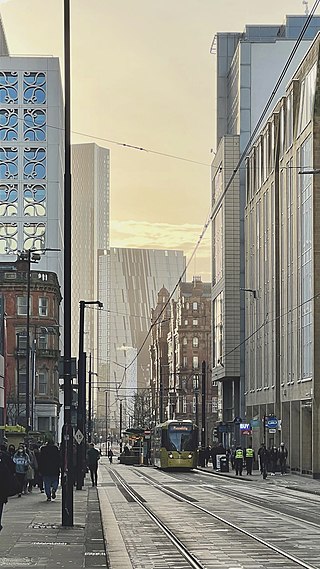
Mosley Street is a street in Manchester, England. It runs between its junction with Piccadilly Gardens and Market Street to St Peter's Square. Beyond St Peter's Square it becomes Lower Mosley Street. It is the location of several Grade II and Grade II* listed buildings.

Asia House at No. 82 Princess Street, Manchester, England, is an early 20th century packing and shipping warehouse built between 1906 and 1909 in an Edwardian Baroque style. It is a Grade II* listed building as at 3 October 1974. Nikolaus Pevsner's The Buildings of England describes the warehouse, and its companion, No. 86, Manchester House, as "quite splendid ... good examples of the warehouse type designed for multiple occupation by shipping merchants". It attributes its design to I.R.E. Birkett, architect of the Grade II listed companion building, Manchester House, which is similar in design. English Heritage attributes it to Harry S. Fairhurst. Asia House has an "exceptionally rich" entrance hall and stairwell, "lined with veined marble and green and cream faience, with designs of trees and Art Nouveau stained glass".

Lancaster House in Whitworth Street, Manchester, England, is a former packing and shipping warehouse built between 1905 and 1910 for Lloyd's Packing Warehouses Limited, which had, by merger, become the dominant commercial packing company in early 20th century Manchester. It is in the favoured Edwardian Baroque style and constructed with a steel frame clad with granite at the base and Accrington red brick and orange terracotta. The back of the building is plain red brick. It is a Grade II* listed building as of 2 October 1974.
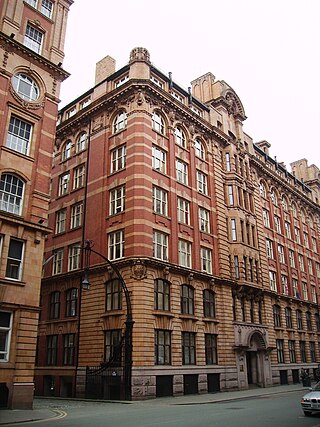
India House in Whitworth Street, Manchester, England, is a packing and shipping warehouse built in 1906 for Lloyd's Packing Warehouses Limited, which had, by merger, become the dominant commercial packing company in early-20th century Manchester. It is in the favoured Edwardian Baroque style and is steel-framed, with cladding of buff terracotta and red brick with buff terracotta dressings. It is a Grade II* listed building as of 2 October 1974.
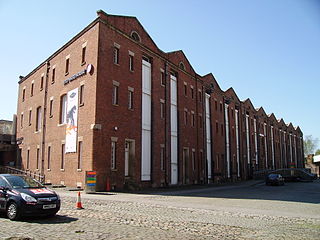
The 1830 warehouse, Liverpool Road, Manchester, England, is a 19th-century warehouse that forms part of the Liverpool Road railway station complex. It was built in five months between April and September 1830, "almost certainly [to the designs of] the Liverpool architect Thomas Haigh". The heritage listing report attributes the work to George Stephenson and his son, Robert. It has been listed Grade I on the National Heritage List for England since May 1973.

Portland Street is a street in Manchester, England, which runs from Piccadilly at its junction with Newton Street south-westwards to Oxford Street at its junction with Chepstow Street. The major buildings of Portland Street include the largest former warehouse in the city centre, Watts Warehouse, the former Bank of England Building and other former warehouses on the corners of Princess Street.
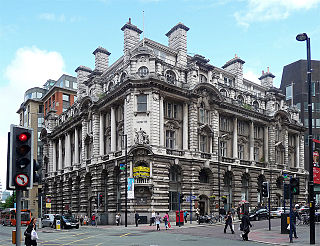
53 King Street is an Edwardian Baroque bank on King Street in Manchester, England. Designed by architect Charles Heathcote, it opened in 1913 and was granted Grade II listed building status in 1974. It used to house a branch of Lloyds TSB. In 2009, the building was sold for £6 million. The building stands on the site of the old Manchester Town Hall.

The Redfern Building is a Grade-II listed building which was completed in 1936 in Manchester, England. The building is situated on Dantzic Street and meets the junction of Mayes Street and Hanover Street. Redfern was originally built for office and warehouse use.

The Rylands Building is a Grade II listed building and former department store on Market Street in Manchester, England. It is situated in the Smithfield conservation area, which was known for its markets and textile warehouses, close to the Piccadilly area of Manchester city centre.
